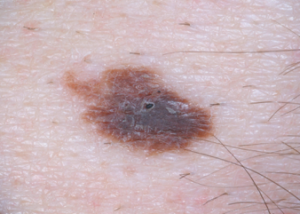
Does that bluish black freckle (or what IS it?!) have you panicking it might be melanoma?
“The bluish color in many pigmented lesions represents pigment that is deeper in the dermis than the pigment that appears brown or black,” explains Dr. Jennifer Gordon, who is board certified by the American Board of Dermatology; she practices at Westlake Dermatology located in Austin, Texas.
“This is called the Tyndall phenomenon and it is all physics. Blue nevi can be benign but also can be atypical or melanomas.”
The Tyndall effect is when light gets scattered by the matter that it hits. In this case, the matter is the pigmented cells of a freckle or mole (nevus; plural: nevi).
There is no connection between this scattering and the likelihood that a mole or freckle will morph into melanoma.
It’s just that people aren’t used to seeing skin pigmented spots showing as bluish black.
That all said, Dr. Gordon points out that these pigmented spots are not exempt from the rules of self-skin exams.
A bluish black mole or freckle needs to be checked for any changes that could signal cancer, but do NOT panic simply because the spot has a blue or blackish tinge to it.

Dannii Brighton, CC
These colors, in and of themselves—if the spot has always appeared this way — do not signal the presence of melanoma or the increased risk of this cancer.
The key, says Dr. Gordon, is the ABCDE’s of melanoma:
- Is the spot or mole noticeably or newly assymetrical?
- Is the border jagged or odd looking?
- Is the color changing? Yes, changing is the key word, since normal moles can be grey, light tan, blackish and even red.
- Is the diameter the size of a pencil eraser? Larger moles are more likely to become malignant.
- Is the mole evolving, changing in some way, developing a crust or bleeding or itching, for instance?
Make note of the colors of your moles.
Have a dermatologist especially check the ones that concern you, especially the bluish black ones.
For added peace of mind, request that the doctor examine your moles with a dermatoscope — a handheld lens that magnifies and illuminates the pigmented area.

Dr. Gordon’s interests include medical dermatology, particularly the treatment and prevention of melanoma and other skin cancers in athletes. For 2016, 2017 and 2018 Texas Monthly Magazine selected her as one of the Texas Super Doctors Rising Stars.
 Lorra Garrick has been covering medical, fitness and cybersecurity topics for many years, having written thousands of articles for print magazines and websites, including as a ghostwriter. She’s also a former ACE-certified personal trainer.
Lorra Garrick has been covering medical, fitness and cybersecurity topics for many years, having written thousands of articles for print magazines and websites, including as a ghostwriter. She’s also a former ACE-certified personal trainer.
.









































